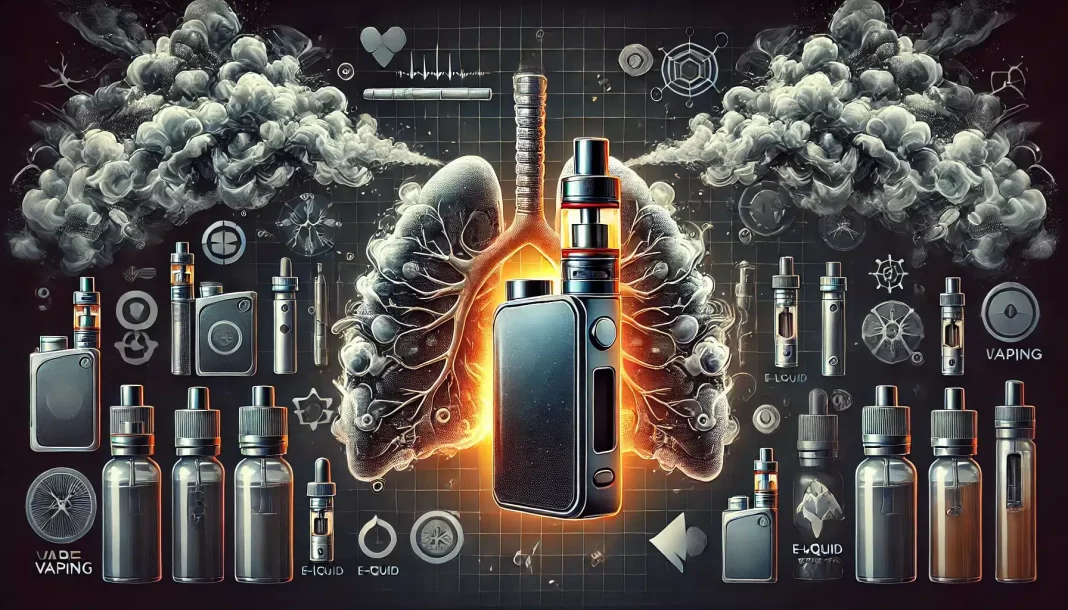In a shocking and life-threatening incident, 32-year-old Jordan Brielle from Ohio had two liters of “black and bloody” fluid, primarily vaping fluid, surgically removed from her lungs. This disturbing case has ignited urgent discussions about the health dangers associated with vaping. Brielle’s story, which serves as a terrifying reminder of the long-term damage vaping can cause, unfolded after her addiction to vaping escalated to dangerous levels, ultimately leading to a medical crisis that nearly claimed her life.
Brielle’s Story: From Smoking to Vaping Addiction
Brielle’s vaping journey began as an alternative to smoking cigarettes. Like many, she switched to vaping in 2021, convinced it was a safer option than traditional smoking. However, what started as a “healthier” alternative quickly spiraled into a full-blown addiction. Brielle admitted to spending up to $500 a week on vape products and would never be without her vape, she even took it into the shower and slept with it at night.
Despite realizing how dependent she had become, Brielle continued vaping heavily, unknowingly putting her life at risk. Vaping was initially viewed as a harm reduction tool for people trying to quit smoking, but Brielle’s case underscores the addictive nature of nicotine-based vape juices and the risks associated with long-term use.
The Medical Crisis: Black and Bloody Fluid in the Lungs
Brielle’s symptoms escalated in late 2023 when she began feeling an unrelenting heaviness in her chest, accompanied by persistent coughing and difficulty breathing. Initially misdiagnosed as a respiratory infection, her condition worsened despite several hospital visits. Brielle described the sensation as “80 pounds of pressure” on her chest. Her worst fears were realized when she collapsed at home, unconscious, with black mucus oozing from her mouth and nose.
Her partner called for emergency help, and doctors quickly discovered that her lungs were filling with fluid. Medical professionals determined the source of the problem: excessive buildup of vape juice and other toxic substances in her lungs. Over the course of her hospitalization, two liters of black and bloody fluid—the result of prolonged vaping, were removed from her lungs.
Brielle’s case is not the first where vaping has been linked to severe lung damage, but the amount of fluid found in her lungs shocked even experienced doctors. She was placed in a medically induced coma for 11 days to allow her lungs to recover from the trauma.
Vaping: What We Know About Its Health Risks
Brielle’s ordeal has raised significant questions about the long-term health risks of vaping, particularly in young adults who believe it is a safe alternative to smoking. In reality, vaping can cause significant damage to the lungs, heart, and other systems. While e-cigarettes do not contain the same carcinogens as traditional cigarettes, vape juice is composed of a mix of chemicals, including propylene glycol, glycerol, flavorings, and nicotine, all of which can cause inflammation and damage to lung tissues when inhaled regularly.
One of the biggest concerns is vaping-related lung injury, often referred to as EVALI (E-cigarette or Vaping product use-Associated Lung Injury). Although EVALI cases surged in 2019, especially among users of THC-infused vaping products, nicotine-based vaping has also been shown to cause chronic lung inflammation. In Brielle’s case, the constant inhalation of chemicals from the vaping fluid may have led to chemical burns, inflamed lung tissues, and the dangerous buildup of fluid.
The Role of Nicotine and Vape Fluid
Nicotine plays a significant role in the addictive nature of vaping. A highly addictive stimulant, nicotine increases heart rate and blood pressure, which can contribute to heart disease. But in vaping, it is the additional ingredients, like flavorings and humectants (substances that retain moisture) that can cause serious health risks. Studies show that when these chemicals are heated, they can release harmful compounds, such as formaldehyde and acrolein, which are toxic to the lungs.
Vaping fluid, especially in the quantities Brielle consumed, can cause long-term damage to lung tissues. Black and bloody fluid like what was found in her lungs is often a sign of severe inflammation and potentially irreversible damage. The color and consistency of the fluid indicate the body’s reaction to the chemicals in the vape juice, as well as the body’s attempt to expel toxic substances.
Vaping and Addiction: How Common Is It?
Despite growing awareness of vaping-related risks, nicotine addiction continues to drive many users toward excessive vaping habits. In Brielle’s case, her addiction was so severe that she couldn’t go a few minutes without vaping. This type of dependency is not uncommon, particularly among younger users who perceive vaping as less dangerous than smoking.
Surveys show that an increasing number of teens and young adults are picking up vaping as a trendy and socially acceptable habit. Many, like Brielle, may not realize the addictive nature of nicotine or the potential damage that extended vaping can do to the body.
Long-Term Health Impacts and Future Concerns
Brielle’s story is a cautionary tale about the long-term health risks associated with vaping, particularly in heavy users. Even though vaping is still relatively new compared to smoking, doctors and researchers are increasingly raising alarms about the potential for chronic lung disease, cardiovascular damage, and, in severe cases, fatal lung injuries.
Studies are still being conducted to understand the full scope of vaping’s impact on long-term health. However, the evidence so far points to significant risks, especially when people vape consistently and in large quantities. While it may not contain tar like traditional cigarettes, vaping’s risks are now being seen in cases like Brielle’s, where the damage to her lungs was almost fatal.
Conclusion: A Wake-Up Call for Vapers
Brielle’s harrowing experience serves as a wake-up call for the many individuals who believe that vaping is a safer alternative to smoking. The two liters of black and bloody fluid removed from her lungs demonstrate just how dangerous long-term vaping can be. Despite its reputation as a healthier option, vaping exposes users to a range of chemicals that can lead to serious health issues, including severe lung damage and even death.
For those who vape or are considering vaping, it’s crucial to be aware of the potential risks. Addiction can take hold quickly, and the effects can be devastating. Brielle’s message to other vapers is clear: “Don’t let this happen to you.” Her story underscores the importance of public awareness and the need for continued research into the long-term effects of vaping on the lungs and overall health.





